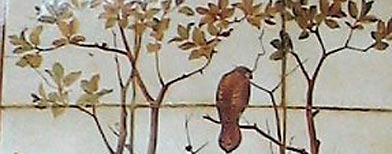The Daily Drift
Today's horoscope says:Birthdays do seem to crop up all at the same time, don't they?
Makes sense, though.
We know what we like, and whether or not we do it consciously, we recognize it when it walks up to us.
This time out, just to make life a little bit easier, if you're invited to a party for a friend of a friend, check out that left hand for a ring before you start sending out those unmistakably 'I'm So Interested' vibes.
See?
Age does bring wisdom.
Some of our readers today have been in:
Auckland, Auckland, New Zealand
Montreal, Quebec, Canada
London, England, United Kingdom
Sydney, New South Wales, Australia
Kuala Lumpur, Wilayah Persekutuan, Malaysia
Hamilton, Ontario, Canada
Maastricht, Limburg, Netherlands
Groningen, Groningen, Netherlands
Birmingham, England, United Kingdom
Bilbao, Pais Vasco, Spain
Perth, Western Australia, Australia
Barcelona, Catalonia, Spain
Harrow, England, United Kingdom
Paris, Ile-De-France, France
as well as Malta, Bulgaria, Israel, Finland, Austria, Norway, Georgia, Mexico, Peru, Kuwait, Serbia, Bangladesh, Latvia, Greece, Scotland, Hong Kong, Denmark, Wales, Iran, Singapore, Poland, Taiwan, Sweden, Afghanistan, Belgium, Tibet, Croatia, Pakistan, Romania, Paraguay, Sudan, Vietnam, Argentina, Cambodia, Egypt, France, Estonia, Puerto Rico, Maldives, Qatar, Brazil, New Zealand, United Arab Emirates, Slovenia, China, Iraq, Ecuador, Nigeria, Colombia, Chile, Honduras, Paupa New Guinea, Moldova, Venezuela, Germany, Mexico, Saudi Arabia, Ireland, Czech Republic, Vietnam, Norway, Finland and in cities across the United States such as Silverdale, Greensboro, Red Plains, Copperpolis and more.
Today is:
Today is Thursday, January 20, the 20th day of 2011.
There are 345 days left in the year.
Today's unusual holiday or celebration is:
Camcorder Day.
Don't forget to visit our sister blog!


 In 1993, the visitor began leaving notes, starting with one that read: "The torch will be passed." A note in 1998 indicated the originator of the tradition had died and passed it on to his two sons. The sons didn't seem to take the duty as seriously as the father. One left a note in 2001 referencing the Super Bowl and another in 2004 implying criticism of France over its objections to the U.S. invasion of Iraq, upsetting many of the traditionalists. When the Poe toaster didn't show last year, Mr. Jerome theorized that the 200th anniversary of Poe's birth in 2009 might have been considered the appropriate stopping point.
In 1993, the visitor began leaving notes, starting with one that read: "The torch will be passed." A note in 1998 indicated the originator of the tradition had died and passed it on to his two sons. The sons didn't seem to take the duty as seriously as the father. One left a note in 2001 referencing the Super Bowl and another in 2004 implying criticism of France over its objections to the U.S. invasion of Iraq, upsetting many of the traditionalists. When the Poe toaster didn't show last year, Mr. Jerome theorized that the 200th anniversary of Poe's birth in 2009 might have been considered the appropriate stopping point.











 Louis Mantin inherited a fortune and became a patron of the arts and of high living. He constructed a fine mansion in his home of Moulins, France and filled it with custom woodwork, relics from antiquity, and art. Mantin died in 1905, and had stipulated in his will that his home should become a museum in 100 years.
Louis Mantin inherited a fortune and became a patron of the arts and of high living. He constructed a fine mansion in his home of Moulins, France and filled it with custom woodwork, relics from antiquity, and art. Mantin died in 1905, and had stipulated in his will that his home should become a museum in 100 years.

 George Phillips was going up to bed when his wife told him that he'd left the light on in the garden shed, which she could see from the bedroom window.
George Phillips was going up to bed when his wife told him that he'd left the light on in the garden shed, which she could see from the bedroom window.










 If you’ve ever had to deal with debt collectors, you know that they’re relentless. How relentless? Let’s just say that they don’t let a little pesky thing like death deter them from getting back every penny they’re owed!
If you’ve ever had to deal with debt collectors, you know that they’re relentless. How relentless? Let’s just say that they don’t let a little pesky thing like death deter them from getting back every penny they’re owed!





 Don’t like to do chores? Well, now you’ve got valid *medical* excuse not to do so. Turns out that doing housework may be dangerous to your health:
Don’t like to do chores? Well, now you’ve got valid *medical* excuse not to do so. Turns out that doing housework may be dangerous to your health:




 The amoeba species Dictyostelium discoideum slime mold (or dicty, as scientists lovingly call it) is one fascinating organism. For instance, its life cycle involves unicellular amoeba, then a multicellular slug that scoots around to find food, then a "fruiting body" to disperse spores to new growing areas.
The amoeba species Dictyostelium discoideum slime mold (or dicty, as scientists lovingly call it) is one fascinating organism. For instance, its life cycle involves unicellular amoeba, then a multicellular slug that scoots around to find food, then a "fruiting body" to disperse spores to new growing areas.

